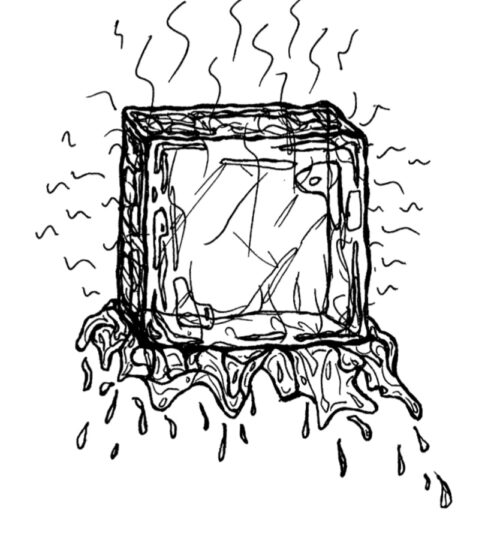Climate Change
New Exhibit Engages Visitors at the Harvard Museum of Natural History
By MARISSA GARCIA and CHIDAMBARAM THILLAIRAJAH
“The more clearly we can focus our attention on the wonders and realities of the universe about us, the less taste we shall have for destruction…”
 When Rachel Carson accepted the National Book Award of 1963, she delivered this prudent peroration in response to the ever-increasing urbanization of man, urging the audience to consider the gravity of their sinking footprint upon the environment. Likewise, by evoking Carson’s words, the new Climate Change exhibit at the Harvard Museum of Natural History—which opened at the beginning of February—exhorts these same sentiments. Upon entering this Climate Change exhibit, built in collaboration with the Harvard University Center for the Environment, visitors are immediately met with these words of Carson printed on one of the initial placards lining the exhibit.
When Rachel Carson accepted the National Book Award of 1963, she delivered this prudent peroration in response to the ever-increasing urbanization of man, urging the audience to consider the gravity of their sinking footprint upon the environment. Likewise, by evoking Carson’s words, the new Climate Change exhibit at the Harvard Museum of Natural History—which opened at the beginning of February—exhorts these same sentiments. Upon entering this Climate Change exhibit, built in collaboration with the Harvard University Center for the Environment, visitors are immediately met with these words of Carson printed on one of the initial placards lining the exhibit.
The nature of the exhibit’s location is transient. Situated between the Earth and Planetary Sciences gallery and the Peabody Museum of Archaeology and Ethnology, the central space echoes and embodies this Carson quote. The layout is tactfully adroit. When the visitors walk through the EPS gallery, geodes and crystals communicate the splendor of our mantle’s natural geological processes. When they cross into the Climate Change exhibit, they are inundated—through intense imagery of hurricanes and storms-—by the inevitable degradation of this splendor. And as they pass over into the Peabody, they are then surrounded by artifacts of American ancestors, instilling an enduring urgency to preserve these histories of humanity and to take action to protect future generations.
The exhibit begins with a large screen cycling through headlines extracted from several publications, spanning from the Wall Street Journal to the Los Angeles Times, documenting extreme weather events during 2018. Each headline is swiftly followed by stark footage of these deafening events. Storms rain down floods sweep through cities, collectively leaving behind vast expanses of sunken suburbia. These powerful images elicit an intractable awe at the sheer force of the recent chaos in all too familiar of settings. The visceral scenes strive to draw forth a desire in the viewer to mitigate the damage of these catastrophes while they still have the luxury of actionability.
The walls of the exhibit are lined with an array of placards, each one documenting increasingly problematic phenomena and contextualizing them through images and descriptions—written in a conspicuous red font—of the damage they inflict. One placard details the rapidly spreading rash of coral bleaching. Visuals of vibrant and colorful reefs are sharply juxtaposed with bone-white, bleached coral—lending emphasis to the nuances of how rising ocean temperature are laying claim not only to our coral reefs but also to the robust, unique ecosystems that reside within. Another placard, explicating the correlation between global warming-induced droughts and wildfires, seems unexpectedly small compared to the scale of the wall-encompassing, ravenous forest fire image that it is laid upon. Yet another placard explains how rising temperatures contribute to increasing intensity of nor’easters, while stunning images provide a more direct insight into the utter magnitude of these powerful storms threatening New England. Ultimately, these carefully curated images and writings provide an overview of the global consequences of modern man-made climate change that is distinctly approachable. Despite the theme that climate change is a global responsibility, the exhibit still succeeded in localizing the changes, connecting trends back to the very real concerns here in Massachusetts.
The exhibit closes with a curious semicircular screen in the shape of an earth, with pixelated geographical continents upon it. At the push of a button on the signboard, this device begins a skillfully narrated digitalized demonstration of shifting glacial patterns and rapidly receding land ice. Decades and centuries of slow incremental change are condensed into mere minutes in this effective and engaging presentation. This earth-modeled screen clearly visualizes for visitors important trends and changes so large and gradual in scope that they can often lose their meaning when abstracted into conventional forms of transferring information. It is easily the hallmark of the exhibit.
The exhibit was overall textually-heavy, and although it included three interactive screen-oriented activities, the language used in the educational videos much exceeded elementary-level literacy– an insight into what audience this exhibit was catered toward. Though it is crucial to familiarize the youth with the concept of climate change, it remains perhaps even more pertinent to educate adults about the reality of our planet’s future, as adults are consumers with the autonomy of capitalistic choice; they choose which climate-forward industries to support, they choose which fisheries to sustain, and they choose if they want to invest in sustainable-energy sources. Effective measures against climate change resides in the choice of the educated consumer, and, with this exhibit, the Harvard Museum of Natural History is taking active strides toward ameliorating any of these educational gaps.
Marissa Garcia ‘21 (marissagarcia@college.harvard.edu) and Chidambaram Thillairajah ‘21 (cthillairajah@college.harvard.edu), through their studies of the biological sciences, are intrigued by how their role as future scientists will evolve along with the changing climate.

